There are three ways to get from Delhi to Varanasi: flight, train or bus. Your budget, preferred travel style and time will determine your choice. Flights are relatively cheap and very fast, but the advantage of taking a bus or train is that you can enjoy the scenery and experience a long-haul trip in India. Below are detailed information on each mode of transport:
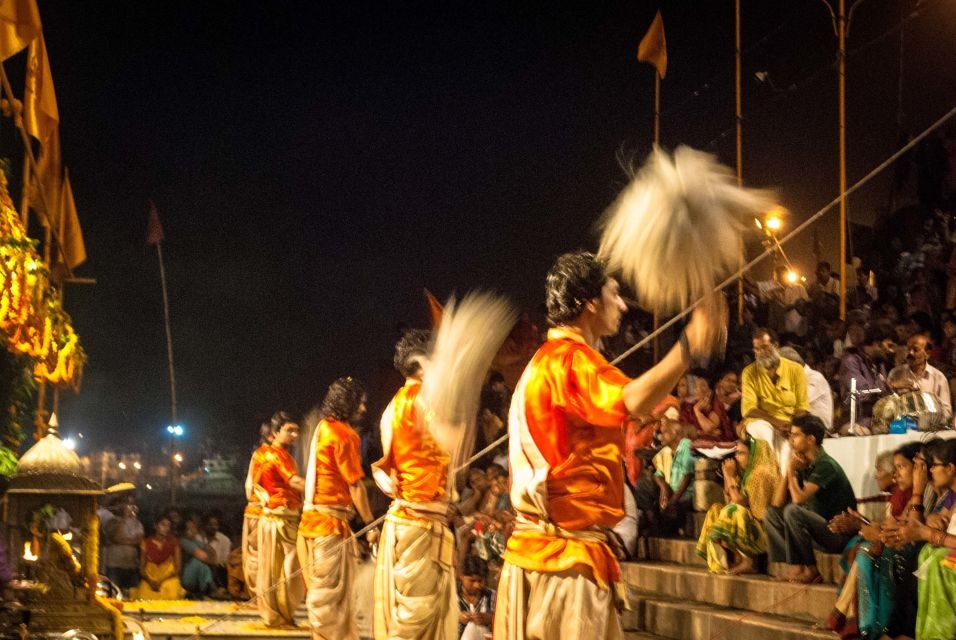

The winter months from November to February are the best time to visit Varanasi. The temperatures can be quite chilly as Varanasi is located in northern India, but the weather during this time is more pleasant for sightseeing, exploring and walking. Average daily temperatures range between 15 and 21°C (60 to 70°F). In the evening, temperatures often drop to 7 to 13°C (40 to 50°F).
Varanasi is all about an emotional journey: discovering the famous Ghats, sailing down the Ganges or appreciating the simplistic beauty of the ancient temples on the riverbanks, under the glow of the rising sun. While there are plenty of ancient temples, forts, and special sites to see, one should set aside a good chunk of time to observe all the special rituals that take place daily in Varanasi. While it is difficult to narrow down the number of things to do in Varanasi, the five listed below are the must-see sites, events, and activities:
Ghats are large, flat steps built into the ground that lead directly down into the Ganges. They are used by pilgrims to enter the water to wash away their sins, pray, and worship. The Manikarnika Ghat is a little different. It is the main “burning ghat,” the most prosperous cremation site for a Hindu. On these steps, the body is immersed in the Ganges before being burned with wood on the steps. Tourists are allowed to watch the ceremony, but respect is essential. Photography is absolutely not allowed. You can watch the ceremonies from the top of nearby buildings. You will likely be invited to these places by “guides” who will ask you to make donations for the ceremony in exchange for taking you there.
Good to know: Varanasi is the holiest place to die for Hindus, as it is believed that dying and being cremated here frees you from the cycle of reincarnation. Some people travel to Varanasi just to die in the holy city.
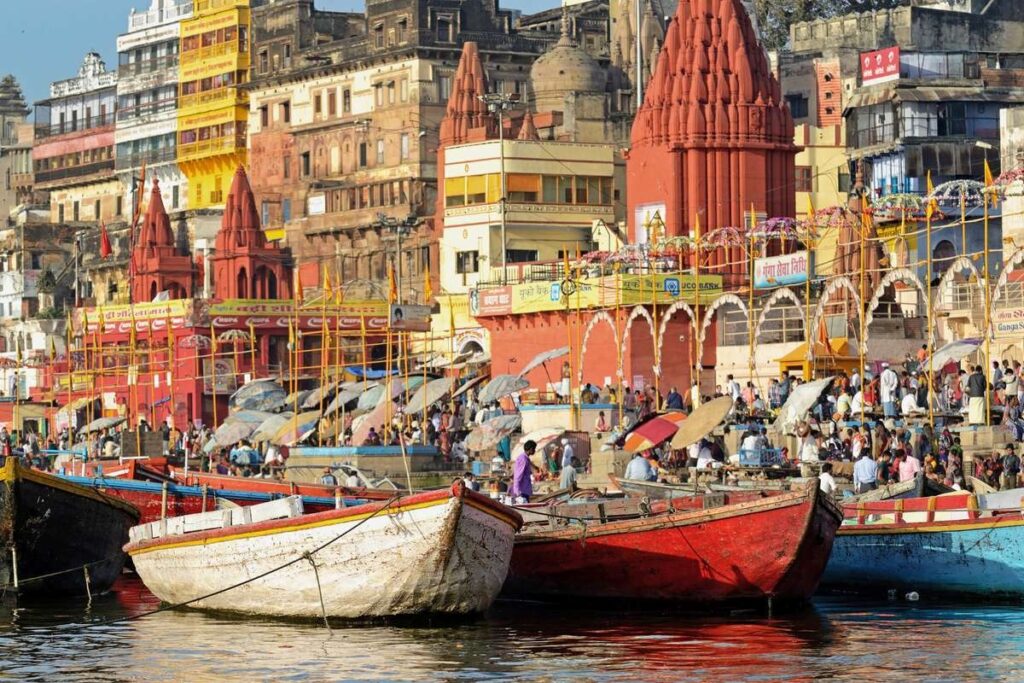

Change your perspective of the famous ghats and book a boat ride on the Ganges, at sunrise or sunset. Watching people bathe and pray in the water as the sunlight illuminates the ghats and buildings of the city is a magical experience and certainly one of the best things to do in Varanasi. It also offers a different perspective for photographers looking for the perfect shot.
Good to know: Traditional rowboats are available all along the river and the price can be negotiated.
As the holiest city in India, it is fair to assume that there are a lot of temples here. They are literally found on every corner, but the most spectacular is Kashi Vishwanath. Built in 1776 and dedicated to Lord Shiva, this temple holds no stone unturned. From an aesthetic point of view, the temple is breathtaking: the dome and the tower are covered with 800 kilograms of gold. It is also one of the holiest (if not the holiest) Hindu temples in the world. Many saints have visited it and pilgrims attribute the visit to this temple and a bath in the Ganges as the path to liberation.
Good to know: This temple is one of the twelve traditional Jyotirlinga temples in India, the most powerful and sacred place to worship Lord Shiva.
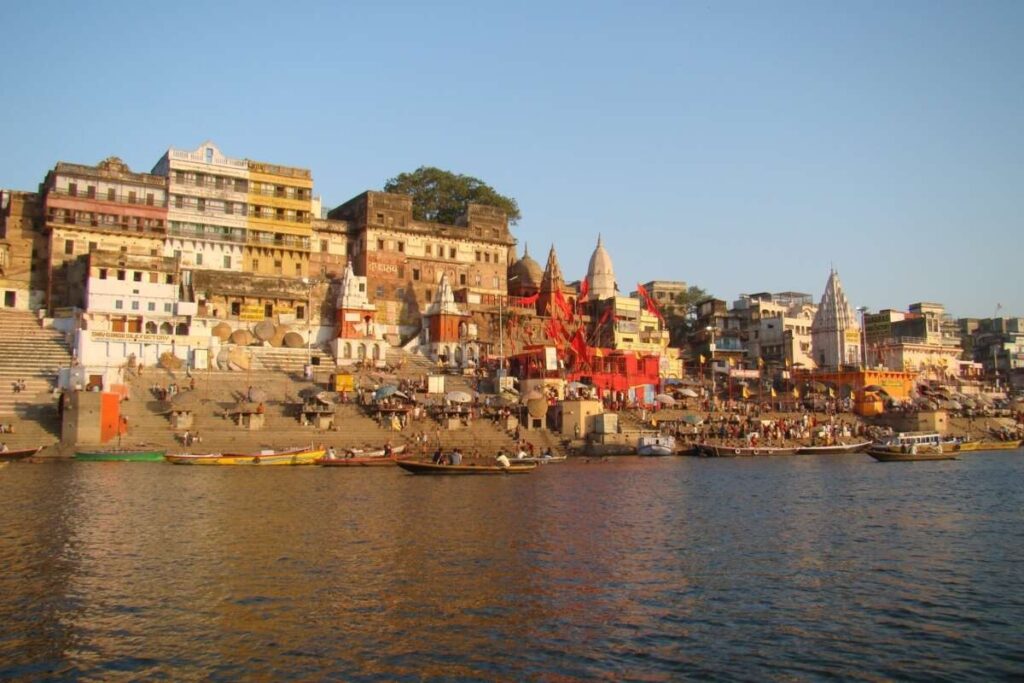

This is a nighttime event hosted by a group of young priests dressed in traditional attire on the banks of the Ganges at Dashashwamedh Ghat. The ceremony is a testament to commitment and devotion to Lord Shiva. A huge crowd gathers around the ghat, lit by copper lamps, while mantras and chants fill the air as the ceremony begins. Incenses are burned, conch shells are blown, and loud music is played as the priests perform their rituals. It is a truly unique way to experience this holy city, making Dashashwamedh Ghat one of the best places to visit in Varanasi.
Good to know: The aarti takes place every evening at 6:45 pm and lasts for about 45 minutes. Take an evening boat ride to Dashwamedh Ghat for the best view of the aarti ceremony.
Get lost in the city, soak up the real culture and witness everyday life in its purest form. Leave the Manikarnika Ghat behind and wander wherever you please. You will find street food, boutiques, guest houses and restaurants all crammed into the old narrow alleys. Don’t miss out on visiting the main shopping areas of Vishwanath Lane, Thateri Bazaar and Godowilia Market, all within a 20-minute walk or less from the famous ghat. These markets offer bags, ornate jewellery, shoes, clothes, silk sarees, bangles, textiles, religious items, trinkets, wooden carvings, copperware and much more.
Good to know: Varanasi is famous for its beautifully colored Banarasi silk sarees. They can be worn wrapped around the waist like a skirt or around the bodice like a shoulder shawl. They are an authentic souvenir that is a must-buy in the bazaars.
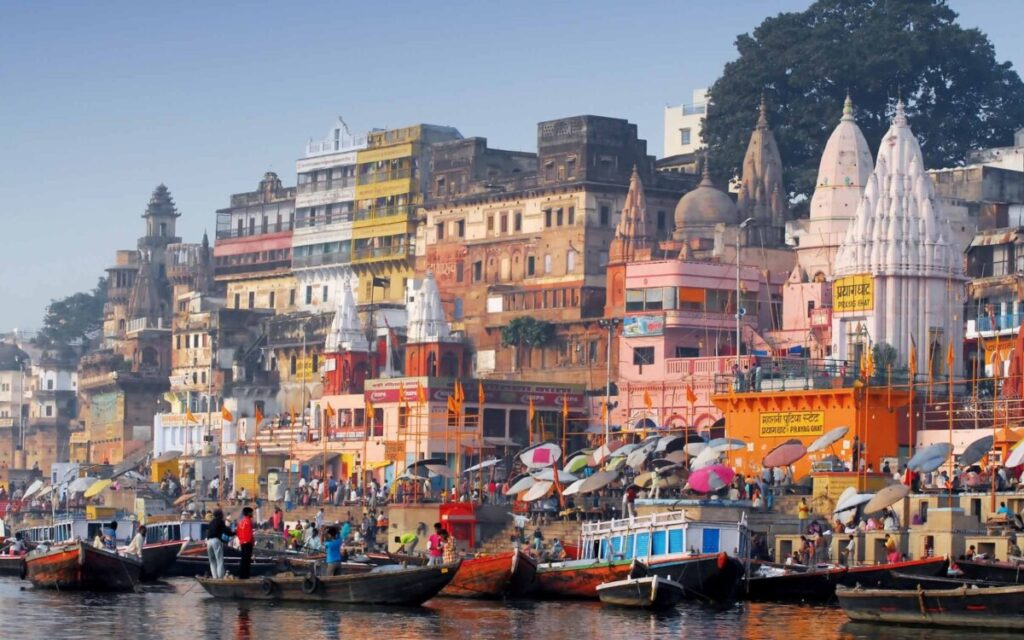
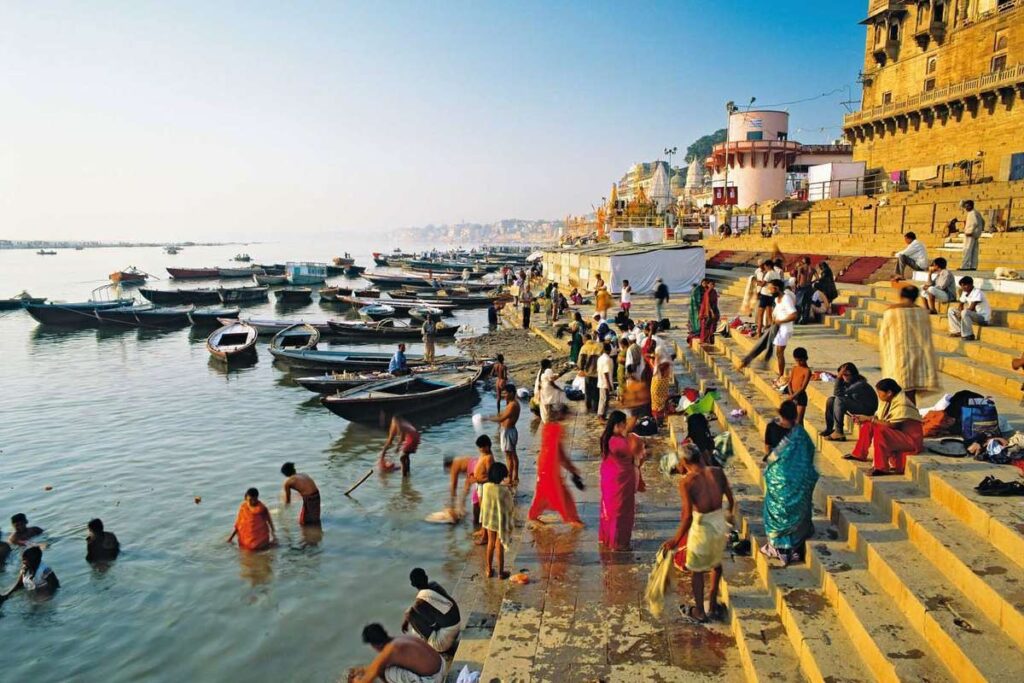
The most popular place to stay and the best starting point for tours and experiences is near the Ganges, close to the ghats. Specifically, the closer you stay to Dashashwamedh Ghat, the closer you will be to the action. If you want to get away from it all, but still be close to the Ganges and the ghats, consider heading 3 kilometers south to the Assi Ghat area.
Brijrama Palace – A Heritage Hotel
This 5-star abode is not only conveniently located 200 metres from the Dashashwamedh Ghat, but is also perched atop its own ghat, offering spectacular views of the Ganges in all its glory. Built in the 18th century, the hotel boasts exquisite interiors and an old-world charm. The rooftop dining area, which offers breathtaking views of the Ganges, is undoubtedly one of the highlights of the hotel. The level of service is exceptional and despite the centuries-old feel of the hotel, each room is equipped with modern comforts.
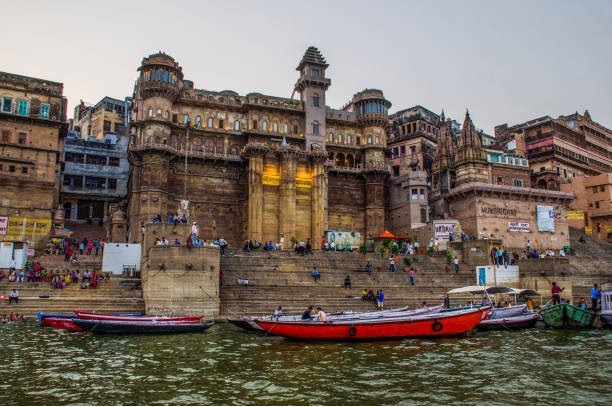

Diamond Hotel
This 3-star hotel is located halfway between Assi Ghat and Dashwamedh Ghat, making it a good choice for those who don’t want to be in the thick of the action but also don’t want to travel far to their main attractions. Free Wi-Fi, airport pickup, and air conditioning in all rooms ensure guests’ comfort. Recent renovations have created spacious rooms and modern ambiances. The hotel has a restaurant and a terrace garden.
HOG Hostel Varanasi
Located about 1 kilometer from Dashashwamedh Ghat, HOG is also within 3 kilometers of our top 5 attractions. Each dorm bed is equipped with a mini wall fan, multiple electrical outlets, and a bedside lamp. The beds are comfortable and offer some privacy thanks to a transparent curtain that can be drawn whenever you want. In addition, the hostel offers free breakfast, a coffee maker in each room, and free Wi-Fi. The clincher? The near-perfect reviews.
There are three ways to get from Delhi to Varanasi: flight, train or bus. Your budget, preferred travel style and time will determine your choice. Flights are relatively cheap and very fast, but the advantage of taking a bus or train is that you can enjoy the scenery and experience a long-haul trip in India. Below are detailed information on each mode of transport:


The winter months from November to February are the best time to visit Varanasi. The temperatures can be quite chilly as Varanasi is located in northern India, but the weather during this time is more pleasant for sightseeing, exploring and walking. Average daily temperatures range between 15 and 21°C (60 to 70°F). In the evening, temperatures often drop to 7 to 13°C (40 to 50°F).
Varanasi is all about an emotional journey: discovering the famous Ghats, sailing down the Ganges or appreciating the simplistic beauty of the ancient temples on the riverbanks, under the glow of the rising sun. While there are plenty of ancient temples, forts, and special sites to see, one should set aside a good chunk of time to observe all the special rituals that take place daily in Varanasi. While it is difficult to narrow down the number of things to do in Varanasi, the five listed below are the must-see sites, events, and activities:
Ghats are large, flat steps built into the ground that lead directly down into the Ganges. They are used by pilgrims to enter the water to wash away their sins, pray, and worship. The Manikarnika Ghat is a little different. It is the main “burning ghat,” the most prosperous cremation site for a Hindu. On these steps, the body is immersed in the Ganges before being burned with wood on the steps. Tourists are allowed to watch the ceremony, but respect is essential. Photography is absolutely not allowed. You can watch the ceremonies from the top of nearby buildings. You will likely be invited to these places by “guides” who will ask you to make donations for the ceremony in exchange for taking you there.
Good to know: Varanasi is the holiest place to die for Hindus, as it is believed that dying and being cremated here frees you from the cycle of reincarnation. Some people travel to Varanasi just to die in the holy city.


Change your perspective of the famous ghats and book a boat ride on the Ganges, at sunrise or sunset. Watching people bathe and pray in the water as the sunlight illuminates the ghats and buildings of the city is a magical experience and certainly one of the best things to do in Varanasi. It also offers a different perspective for photographers looking for the perfect shot.
Good to know: Traditional rowboats are available all along the river and the price can be negotiated.
As the holiest city in India, it is fair to assume that there are a lot of temples here. They are literally found on every corner, but the most spectacular is Kashi Vishwanath. Built in 1776 and dedicated to Lord Shiva, this temple holds no stone unturned. From an aesthetic point of view, the temple is breathtaking: the dome and the tower are covered with 800 kilograms of gold. It is also one of the holiest (if not the holiest) Hindu temples in the world. Many saints have visited it and pilgrims attribute the visit to this temple and a bath in the Ganges as the path to liberation.
Good to know: This temple is one of the twelve traditional Jyotirlinga temples in India, the most powerful and sacred place to worship Lord Shiva.


This is a nighttime event hosted by a group of young priests dressed in traditional attire on the banks of the Ganges at Dashashwamedh Ghat. The ceremony is a testament to commitment and devotion to Lord Shiva. A huge crowd gathers around the ghat, lit by copper lamps, while mantras and chants fill the air as the ceremony begins. Incenses are burned, conch shells are blown, and loud music is played as the priests perform their rituals. It is a truly unique way to experience this holy city, making Dashashwamedh Ghat one of the best places to visit in Varanasi.
Good to know: The aarti takes place every evening at 6:45 pm and lasts for about 45 minutes. Take an evening boat ride to Dashwamedh Ghat for the best view of the aarti ceremony.
Get lost in the city, soak up the real culture and witness everyday life in its purest form. Leave the Manikarnika Ghat behind and wander wherever you please. You will find street food, boutiques, guest houses and restaurants all crammed into the old narrow alleys. Don’t miss out on visiting the main shopping areas of Vishwanath Lane, Thateri Bazaar and Godowilia Market, all within a 20-minute walk or less from the famous ghat. These markets offer bags, ornate jewellery, shoes, clothes, silk sarees, bangles, textiles, religious items, trinkets, wooden carvings, copperware and much more.
Good to know: Varanasi is famous for its beautifully colored Banarasi silk sarees. They can be worn wrapped around the waist like a skirt or around the bodice like a shoulder shawl. They are an authentic souvenir that is a must-buy in the bazaars.


The most popular place to stay and the best starting point for tours and experiences is near the Ganges, close to the ghats. Specifically, the closer you stay to Dashashwamedh Ghat, the closer you will be to the action. If you want to get away from it all, but still be close to the Ganges and the ghats, consider heading 3 kilometers south to the Assi Ghat area.
Brijrama Palace – A Heritage Hotel
This 5-star abode is not only conveniently located 200 metres from the Dashashwamedh Ghat, but is also perched atop its own ghat, offering spectacular views of the Ganges in all its glory. Built in the 18th century, the hotel boasts exquisite interiors and an old-world charm. The rooftop dining area, which offers breathtaking views of the Ganges, is undoubtedly one of the highlights of the hotel. The level of service is exceptional and despite the centuries-old feel of the hotel, each room is equipped with modern comforts.


Diamond Hotel
This 3-star hotel is located halfway between Assi Ghat and Dashwamedh Ghat, making it a good choice for those who don’t want to be in the thick of the action but also don’t want to travel far to their main attractions. Free Wi-Fi, airport pickup, and air conditioning in all rooms ensure guests’ comfort. Recent renovations have created spacious rooms and modern ambiances. The hotel has a restaurant and a terrace garden.
HOG Hostel Varanasi
Located about 1 kilometer from Dashashwamedh Ghat, HOG is also within 3 kilometers of our top 5 attractions. Each dorm bed is equipped with a mini wall fan, multiple electrical outlets, and a bedside lamp. The beds are comfortable and offer some privacy thanks to a transparent curtain that can be drawn whenever you want. In addition, the hostel offers free breakfast, a coffee maker in each room, and free Wi-Fi. The clincher? The near-perfect reviews.
Copyright © 2025 Delighted Journey | All Rights Reserved.